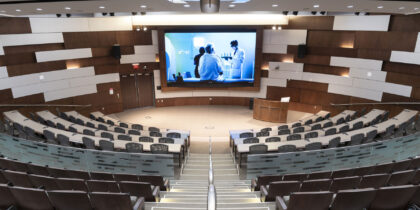The disruptive power of technology has been felt strongly in higher education. Students have high expectations for the technological capacity offered at their chosen institution. Faculty need guidance as they adapt to new learning technologies and methods, and IT staff must be prepared to support the technologies we use today and the ones we will deploy tomorrow.
However, technology’s future in higher education is promising. The same technologies that have disrupted learning also have the capabilities to provide solutions to these and other higher education issues.
Campus Connectivity
Technology has improved our ability to connect and collaborate with each other. It’s also increased our expectations for connectivity everywhere. As more and more students bring their own devices to campus, the need for high-speed wireless access is critical.
Beyond wireless access, schools can offer different types of connectivity to help keep students informed and feeling as if they’re part of the greater campus community through tools like digital signage. A connected network of digital signage displays allows colleges and universities to push out campus-wide messages, department- and location-specific information and emergency updates. They also allow integration with social media to involve all students in the message shared.
New Learning Technologies
Students now expect a more technologically rich and personalized learning experience than many higher education faculty are used to providing.
Just like students in K–12, college students are easily engaged by video-based lessons and other interactive tools. Faculty will need support to find and integrate high-quality, college-level content into their courses. They may want to flip their classrooms, which requires infrastructure to gather and deliver cloud education.
Additionally, tools that gather data and personalize learning for each student will improve the ability of higher education institutions to prepare students for employment. Faculty will need support to deploy these tools, and students (and their parents) will want reassurance that their data is safe within these tools and administrative technologies.
Staff Development
Underpinning these changes is the need for IT staff to be well trained in new education technologies. They also need to feel supported and appreciated by the faculty and administration. The move to cloud education can make support staff fear that they will no longer be needed. But cloud technologies don’t change the need for on-campus support; they just change the type of support needed.
Make sure your administration is on board with providing continuing education to your IT staff so you can keep the best people on your team — and ensure that they remain engaged and effective. Vendor support is also critical as you deploy new technologies. When you work with vendors, make sure you negotiate plenty of support into your contracts.
Looking Ahead
New technologies and learning methods are moving into higher education. As these changes occur, they’re bringing many higher education issues to the forefront. As students work through a digitally enhanced K–12 system, they’ll be expecting the same type of learning personalization and multiple modes of learning that they’re used to. They’ll also be asserting their independence as young adults and bringing myriad different devices to campus.
As technology grows more powerful, it will continue to enhance learning and provide new ways to access education. IT staff, faculty, administrators and vendors will all need to collaborate to ensure that we access its full potential moving forward.
Learn more about how educators are integrating technology into the classroom.







